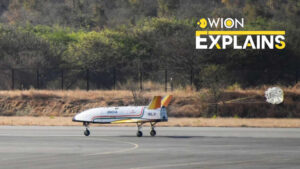APRIL 4, 2023

Spaceplanes are highly sophisticated aerospace vehicles – while within the earth’s atmosphere, they can glide and land on an airstrip like a plane and while in space, they can manoeuvre like a spacecraft. The most common spaceplanes are the 1980s-era American-origin Space Shuttle and the Soviet-origin Buran. But neither of these giant astronaut-ferrying spaceplanes are in operation. In 2023, only the US and China are known to operate autonomous and reusable spaceplanes. India could soon be the third entrant into this exclusive club, thanks to its indigenous spaceplane known as ‘Reusable Launch Vehicle – Technology Demonstrator’ (RLV-TD). This prototype has been developed by the Indian space agency ISRO and its testing is being carried out with the support of Indian Defence lab DRDO and the Indian Air Force.
America has been operating the ‘Boeing X-37B’ spaceplane for nearly a decade and the plane has proven its ability to remain in space for more than 900 days, in a single trip. As per reports, China is widely regarded to operate its own spaceplane, but details are very sketchy. Given that spaceplanes have both civil and military applications, it is certain that no country would ever reveal the real intent and nature of operations being carried out by these autonomous aerospace vehicles.
How do Spaceplanes reach Earth orbit and return ?
Spaceplanes are not standalone vehicles, they ride piggyback on a large rocket during their onward journey . It is the rocket which actually carries the spaceplane to an orbit around the earth. Once in earth orbit, the spaceplane is on its own. It performs its mission and then de-orbits(manoeuvres to re-enter the earth) and gets drawn by earth’s gravitational pull and re-enters the earth’s atmosphere, where it encounters temperatures close to 2000degrees Celsius. As the plane descends into the denser layers of the earth’s atmosphere, it uses its control surfaces (rudder, aileron, elevator) to glide and make a runway landing.
How far has India come ? What is India’s reusable vehicle like ?
On April 2, 2023, the Indian Space Research Organization(ISRO) demonstrated the precise runway landing of an unmanned, fully autonomous, indigenous space plane. The space plane was dropped mid-air from an altitude of 4.5 kms, by an Indian Air Force ‘Chinook’ tandem-rotor helicopter. After being dropped, the space plane glided down and covered a distance of nearly 4.6kms, while performing autonomous navigation, guidance and control calculations. Finally, the plane manoeuvred deftly and landed precisely on a runway at a high-speeds of 350kmph. Top ISRO officials leading the project had told WION that the plane landed just as planned, perfectly along the runway centreline. The landing was so perfect that the spaceplane is said to be in impeccable condition, at the Aeronautical Test Range tarmac in Chitradurga, Karnataka.
In a first in the world, a winged body has been carried to an altitude of 4.5 kms by a helicopter and released for carrying out an autonomous landing on a runway. RLV is essentially a space plane with a low lift-to-drag-ratio requiring an approach at high glide angles that necessitated a landing at high velocities of 350 kmph” said the Indian Space agency, ISRO. The Indian spaceplane prototype weighs 1.6tons(similar to that of a SUV), and measures 6.5meters in length and 3.6meters in breadth. The idea for ISRO’s spaceplane was born nearly two decades ago and development work has been going on for more than ten years. The recent unmanned landing is a validation of how far ISRO has come in mastering sophisticated autonomous technologies and the avionics, computing systems that make it possible.
Explaining the progress of ‘RLV-TD’ testing to WION, ISRO, VSSC Director, Dr S. Unnikrishnan Nair said that the same RLV-TD vehicle had earlier(in 2016) successfully been carried to 65kms altitude by a rocket. From there, the vehicle re-entered the denser parts of the atmospshere at Hypersonic speeds, almost five times the speed of sound (hypersonic speed or Mach5) and finally made a splashdown landing in the Bay of Bengal(simulated runway). However, the ocean landing was a preliminary step and the precise runway landing is a really sophisticated and technologically complex feat that takes forward the progress of making the spaceplane a reality, he added.
What’s next for ‘RLV-TD’ ?
So far, the RLV has shown that it can be flown to the upper atmosphere on a rocket and can come back and make a precise, autonomous runway landing. What remains to be done is, for the RLV to reach space(on a rocket), orbit the earth, carry out experiments, de-orbit, re-enter the earth’s atmosphere.
ISRO Chairman, D.r S. Somanath said that the RLV-TD is a great opportunity for India to develop an ‘ORV'(orbital landing experiment) and that this work was already progressing. ‘ORV’ is an experiment where the space plane is flown to space atop a rocket and then brought back to land on a runway, completely autonomously. “This RLV landing is taking us closer to developing a reusable rocket/landing craft for very specific mission goals” he said.
Dr. Unnikrishnan Nair told WION that the present ‘RLV-TD’ vehicle was meant for demonstration purpose and the actual vehicle would be about 1.6times larger in size. The actual RLV plane is meant to be launched to space atop a modified-GSLV rocket, he said. It is envisioned that the spaceplane would be able to sustain in orbit for almost a month, he added.
On the recent test and the homegrown systems for the same, ISRO said “The runway landing experiment (LEX) utilised several indigenous systems. Localized Navigation systems based on pseudolite systems, instrumentation, and sensor systems, etc. were developed by ISRO. Digital Elevation Model (DEM) of the landing site with a Ka-band Radar Altimeter provided accurate altitude information”. The RLV LEX demanded several state-of-the-art technologies including accurate Navigation hardware and software, Pseudolite system, Ka-band Radar Altimeter, NavIC receiver, indigenous Landing Gear, Aerofoil honey-comb fins and brake parachute system, the Indian space agency added.
Advantages of Autonomous Reusable spaceplanes
The Space shuttle was a reusable space plane, but it cost a huge deal of money to operate. The main role of the space shuttle was to ferry cargo and astronauts to the International space station and bring them back. The shuttle also performed a variety of roles such as placing satellites in orbit, constructing and servicing the International Space station, carrying out space science experiments etc. While the shuttle did render great service to international space missions and transported cargo and astronauts to low earth orbit, it was prohibitively expensive as the per flight cost is estimated at $1.6bn. The shuttle’s ferrying role has been replaced by SpaceX Falcon 9 rockets and Crew dragon capsules.
It must also be noted that there were two catastrophic disasters involving the shuttle, which led to the loss of 14 crew members in total and billions of dollars worth of equipment. When it comes to unmanned and autonomous solutions, the cost is much lower and so are risks. Putting humans on-board an aerospace vehicle makes the mission much more complicated, heavy and expensive, as hundreds of technologies have to be developed and installed for the safe travel and return of the humans.
With an unmanned platform, it is possible to carry out civilian and military experiments in space and bring the plane back. Even in case of a mission failure, there is no loss of precious human life and trained scientific talent. The development of reusable rockets that are capable of vertical landing (as demonstrated by SpaceX), also complements the existence of spaceplanes that can land on a runway. Having such a combination of reusable rocket and reusable space plane can even help perform space missions without leaving behind space debris.
Courtesy/Source: WION

































































































